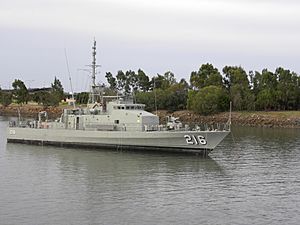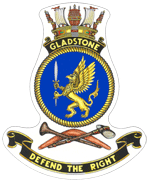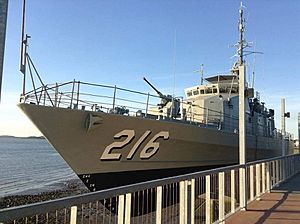HMAS Gladstone (FCPB 216) facts for kids

The former HMAS Gladstone in 2010
|
|
Quick facts for kids History |
|
|---|---|
| Namesake | Port city of Gladstone, Queensland |
| Builder | North Queensland Engineers and Agents |
| Laid down | 7 March 1983 |
| Launched | 28 July 1984 |
| Commissioned | 8 September 1984 |
| Decommissioned | 13 March 2007 |
| Motto | "Defend the right" |
| Nickname(s) | "Sadrock" |
| Honours and awards |
Two inherited battle honours |
| Status | Preserved as museum ship in Gladstone, QLD |
| Badge |  |
| General characteristics | |
| Class and type | Fremantle-class patrol boat |
| Displacement | 220 tons |
| Length | 137.6 ft (41.9 m) |
| Beam | 25.25 ft (7.70 m) |
| Draught | 5.75 ft (1.75 m) |
| Propulsion | 2 MTU series 538 diesel engines, 3,200 shp (2,400 kW), 2 propellers |
| Speed | 30 knots (56 km/h; 35 mph) |
| Range | 5,000 nautical miles (9,300 km; 5,800 mi) at 5 knots (9.3 km/h; 5.8 mph) |
| Complement | 24 |
| Electronic warfare & decoys |
Type 133 Prism ESM |
| Armament |
|
HMAS Gladstone (FCPB 216) was a special kind of boat called a Fremantle-class patrol boat. It was part of the Royal Australian Navy (RAN), which is Australia's navy. The ship was named after the city of Gladstone, Queensland.
Gladstone was built in the early 1980s and started serving in the navy in 1984. For most of its time in service, it worked from a naval base in Cairns. Its main jobs were to protect fishing areas and Australia's borders.
The crew of Gladstone were given a special honour called "Freedom of the City" by Gladstone city three times. This is a way for a city to show respect to a military unit.
In 2007, Gladstone finished its navy service. It was then given to a group called the Gladstone Maritime History Society. They wanted to keep it safe and show it as a museum ship at the Gladstone Maritime Museum.
There were some delays in getting the ship ready for display. But by 2016, the work was finished. Now, you can visit Gladstone and take tours on weekends. It's located in the Gladstone East Shores area, near the Gladstone Marina.
Building a Patrol Boat: Gladstone's Design
Planning for a new type of patrol boat began in the late 1960s. The goal was to create boats that could handle rough seas better. They also wanted to add new weapons and equipment.
The Fremantle-class boats, like Gladstone, weighed about 220 tons when fully loaded. They were about 137.6 feet long and 24.25 feet wide. They sat about 5.75 feet deep in the water.
Two powerful diesel engines moved the ship, turning two propellers. Unlike most ships, the exhaust from the engines went out through vents below the waterline, not a tall funnel. Gladstone could travel very fast, up to 30 knots (about 34 miles per hour). It could also travel a long distance, up to 5,000 nautical miles (about 5,750 miles) at a slower speed.
A crew of 24 people worked on the ship. For protection, Gladstone had a 40mm Bofors gun. It also had two 12.7mm machine guns. At first, it had an 81mm mortar, but this was removed later on.
Gladstone was built in Cairns, Queensland. Its construction started on March 7, 1983. It was launched into the water on July 28, 1984. The ship officially joined the Royal Australian Navy on September 8, 1984. During its time in service, the ship was sometimes called "Sadrock" by its crew.
Gladstone spent its entire time in the navy based at HMAS Cairns in Cairns, Queensland. The Fremantle-class patrol boats mainly worked in the northern waters of Australia.
Their important jobs included:
- Protecting fishing areas from illegal fishing.
- Guarding Australia's borders.
- Helping with immigration and customs duties.
- Supporting law enforcement operations at sea.
- Watching over the oceans (maritime surveillance).
The crew of Gladstone received the "Freedom of the City" honour from Gladstone city for the first time in 1988.
In April 1990, Gladstone caught a Taiwanese fishing boat called Hai Chang 11. This boat was fishing illegally inside Australia's special economic zone. The fishing boat tried to get away, but Gladstone stopped it. The captain of the fishing boat was later charged.
In 2006, Gladstone stopped ten more illegal fishing boats. One of these boats was carrying a large amount of reef fish, about 750 kilograms (1,650 pounds).
The city of Gladstone gave the ship's crew the "Freedom of the City" honour again in July 2000.
The crew received this special honour for a third and final time on Australia Day, January 26, 2007. This was just before the ship was scheduled to finish its navy service. Gladstone was supposed to be decommissioned in February 2007. However, it was sent out on a mission called Operation Resolute at the start of the month. This was to help replace other patrol boats that had problems with their fuel systems.
Gladstone's Final Journey and Museum Life
Gladstone officially ended its navy service in Cairns on March 13, 2007. During its time in the navy, the ship traveled over 610,000 nautical miles. That's like going around the world many times!
On the same day it was decommissioned, Gladstone was given to the Gladstone Maritime History Society. The plan was to turn it into a museum ship and display it at the Gladstone Maritime Museum. After leaving Cairns, the patrol boat sailed to Gladstone. There, it was formally given to the city mayor, who then handed it over to the Society.
Plans to get the ship ready for display were put on hold for a while. This was due to a big worldwide financial crisis that happened around 2007-2010. So, Gladstone was stored at the Gladstone Marina.
In late 2009, new plans were announced to move Gladstone to a more visible spot. The idea was to display the ship out of the water on a special stand once the museum was updated. In November 2014, Gladstone was moved to a special wet dock at East Shores.
The ship was placed on support cradles and then cleaned and repainted. At the start of 2015, people thought it would open to the public around Easter 2015. However, more work was needed to make the ship safe and easy for visitors to access. In October 2015, the Queensland state government provided $116,000 to help with the project. Now, Gladstone is open for tours on weekends, allowing people to explore this historic patrol boat.


